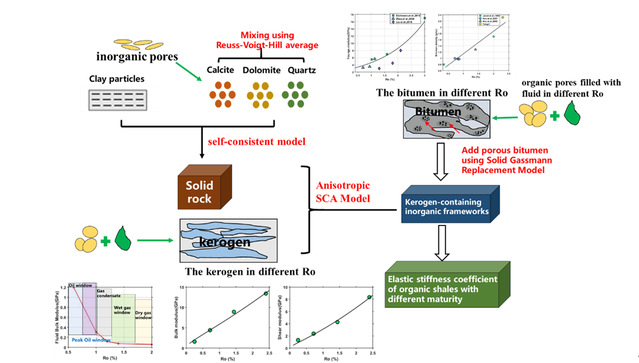Luanxiao Zhao a,b,* , Jinwan Zhu a,b , Xuan Qin c , Gong Rui a,b , Zhenjia Cai a,b , Fengshou Zhang d , De-hua Han c , Jianhua Geng a,b
a State Key Laboratory of Marine Geology, Tongji University, Shanghai 200092, China
b School of Ocean and Earth Science, Tongji University, Shanghai 200092, China
c Department of Earth and Atmospheric Sciences, University of Houston, Houston 77004, USA
d Department of Geotechnical Engineering, Tongji University, Shanghai 200092, China
Abstract
Understanding and modeling the elastic and anisotropic responses of organic shale is crucial for interpreting sonic and seismic data, and hence play a vital role in many fields of Earth and Energy science such as hydrocarbon source rock evaluation, reservoir characterization of unconventional shale plays, cap rock assessment for geological storage of CO2 and nuclear waste disposal. The thermal maturity level significantly controls the geochemistry signature, geological characteristics and geophysical responses of organic shale. We review the rock physics modeling that links the geological feature with elastic responses of organic shale in general. However, current rock physics modeling of organic shales either ignore or qualitative consider the effects of thermal maturity. To construct a quantitatively maturity-constrained rock physics model for shale, we review the evolutionary characteristics of two types of organic matter (kerogen and bitumen) and organic porosity during thermal maturation. We summarize and quantitatively characterize the maturity-dependent elastic properties of organic matter and fluids. We propose a joint geochemistry-rock physics modeling that use various effective medium theories to quantify the effects of thermal maturity level (Vitrinite reflectance, %Ro) on the elastic signatures of inorganic frame, fluids filled porous organic matter as well as their elastic interactions. In particular, the role of kerogen and bitumen on the elastic properties of the organic shale are separately incorporated into the rock physics modeling. The developed rock physics model demonstrates that reservoir parameters (e.g. TOC, porosity and clay content) have distinct impacts on the elastic and anisotropic behaviors of shale reservoirs at different maturity levels. We also use several ultrasonic and sonic logging data sets at various maturity levels, including Jimsar shale formation in NW China, Qingshankou shale formation in NE China and Longmaxi shale formation in SW China, to benchmark the effectiveness of the proposed model. The modeling results show satisfactory agreement with the P-wave velocity, S-wave velocity, density, P-wave anisotropy magnitude, and Swave anisotropy magnitude, only when the appropriate maturity level is given, illustrating the importance of combining organic geochemistry with rock physics modeling. We also discussed the influence of organic matter morphology, the degree of clay alignment as well as overpressure-induced micro-fractures on the elastic and anisotropic responses of organic shale, which can be also considered within the developed rock physics modeling framework.
Full paper:https://doi.org/10.1016/j.earscirev.2023.104627



